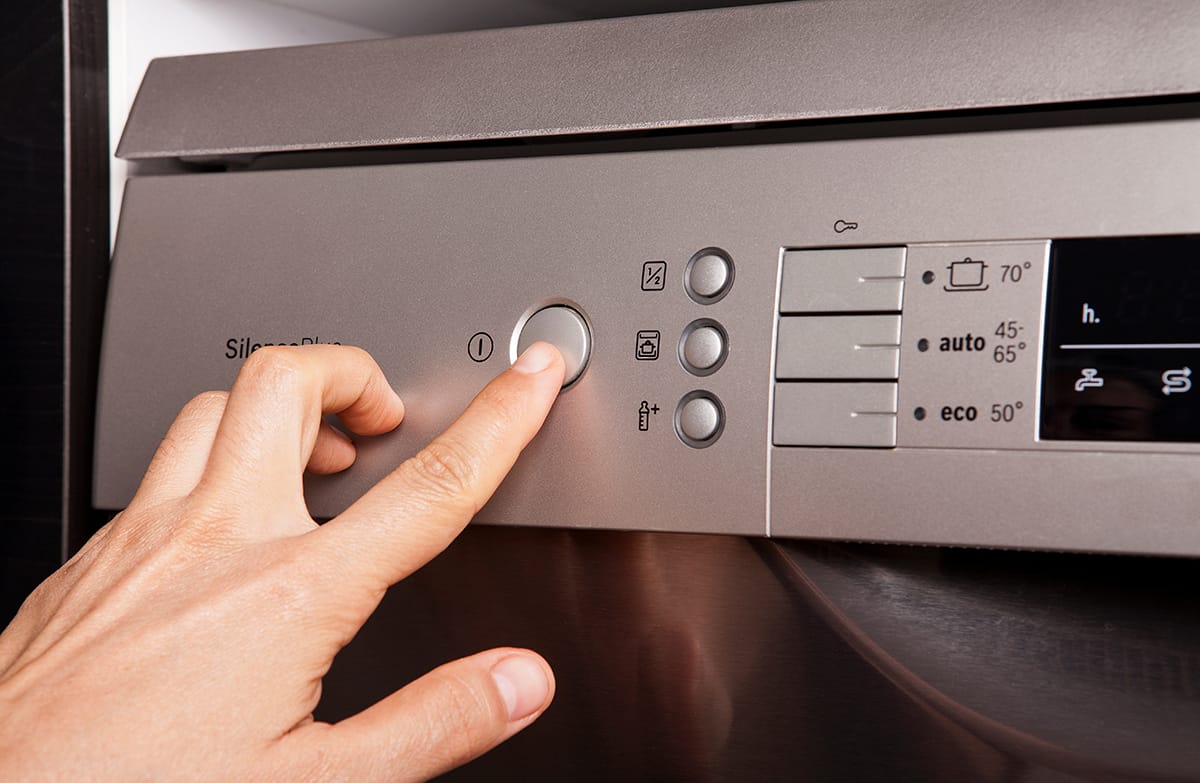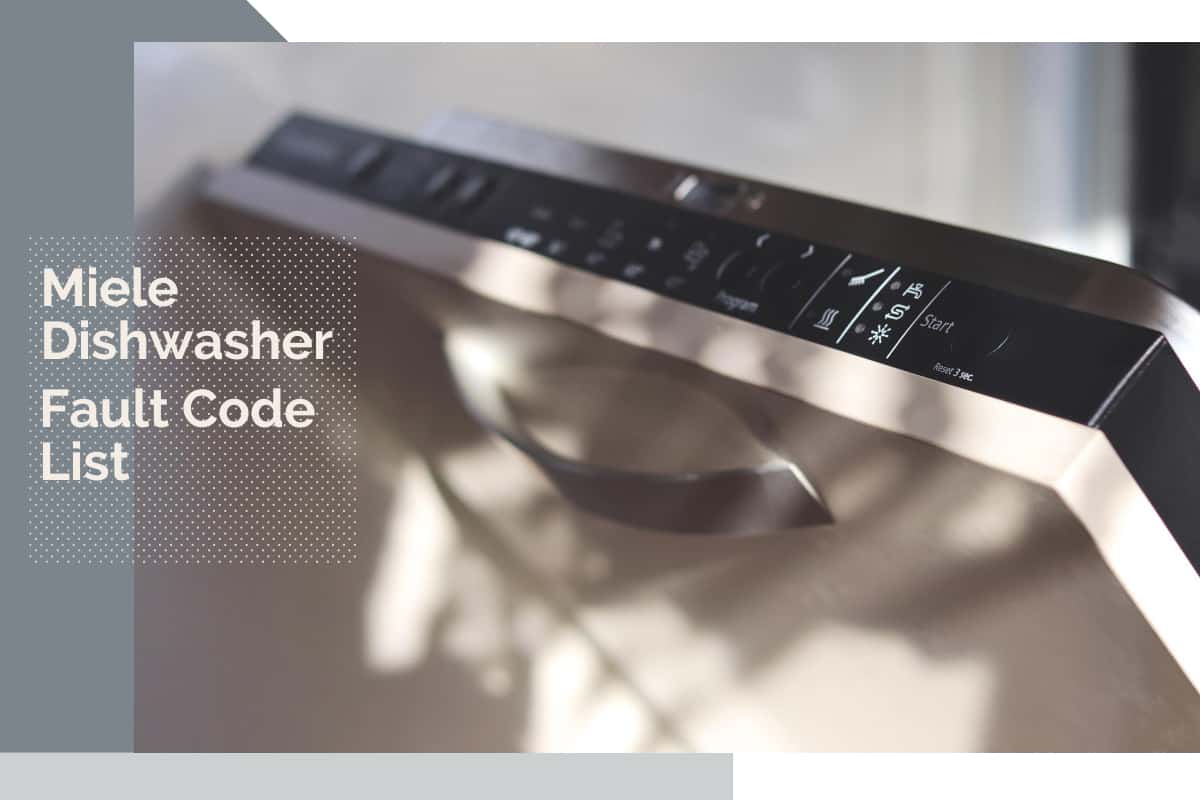If a power tool or household appliance sports a genuine Miele logo, you know you’re getting a high-quality product. Miele’s dishwashers come second to none in terms of convenience and range of features, but you should prepare to pay a hefty price to own one.
However, there may come a time when your Miele dishwasher acts up and doesn’t do what you want. In such a case, the best thing you can do is to decipher the fault code on the digital display to figure out what’s going on.
In this guide, I’ll list the various Miele dishwasher fault codes and describe their causes and solutions.
Miele Dishwasher Fault Codes List
F01—Water or heater thermistor shorted
The thermistor is a fancy word for the temperature sensor built into your dishwasher. Miele dishwashers usually go up to 65°C (149°F) to remove food soils permanently and sanitize dishes. When the F01 error appears, it indicates that the thermistor has short-circuited.
Solution: Examine the thermistor
To do this, you will need to open your dishwasher and measure the thermistor’s resistance level with a multimeter. If it doesn’t register anything, you’ll need to replace the thermistor completely.
F02—Water or heater thermistor open circuit
The F02 fault code also indicates that the thermistor is on the fritz but for a completely different reason. If this code appears, it means that the thermistor is open-circuited—i.e., the circuit is incomplete due to disconnected cables.
Solution #1: Reconnect the cable harnesses
Open the dishwasher and check the heating element’s cables and cable harnesses. Secure them in place before testing your dishwasher for the F02 fault code.
Solution #2: Examine the thermistor
Refer to the Solution provided in the F01 fault code section.
F11—Drainage error
After spraying your dishes with clean or soapy water, the dirty water needs to drain down the drain port and through the outlet line. However, when there’s standing water in your dishwasher, you’ll most likely see an F11 code on the dishwasher’s display.
Solution #1: Empty the filter assembly
My guide on How to Clean a GE Dishwasher Filter is also applicable to Miele dishwashers. Follow the instructions there to empty your Miele’s filter assembly.
Solution #2: Check the drain pump
The drain pump is responsible for flushing dirty water from your dishwasher through the drain line. If it’s blocked, it will have trouble doing its one and only job. Refer to this video by Miele Australia on YouTube to see how to clean the drain pump.
If cleaning the drain pump didn’t work, check it for resistance with a multimeter. A defective drain pump cannot be fixed, so you’ll have to shop for a replacement.
Solution #3: Check the 1 switch
The heat pressure switch tells the dishwasher when to activate and deactivate the heating element. If it’s on the fritz, the dishwasher will not drain water from the tub. So, check the heat pressure switch for damage and replace it if necessary.
F12, F13, F14, and F15—Water intake error
All 4 of these codes refer to a water intake problem. This is a symptom that is associated with multiple causes, but the most common of them are a faulty inlet valve, a faulty circulation pump, and a blocked heat pressure switch.
Solution #1: Check the inlet valve
The inlet valve is connected to your dishwasher via the inlet line (hose or pipe). A damaged valve can reduce the water flow rate to your dishwasher, leaving your dishwasher with less water than it needs to operate. Inspect the valve for damage (rust or limescale buildup) or replace it if necessary.
Solution #2: Check the circulation pump
When water passes through the inlet line, it’s pushed through the spray arms via the circulation pump. Check this pump for resistance with a multimeter, or replace it if it’s completely busted. This video by Scott the Fix-It Guy should help you.
Solution #3: Check the heat pressure switch
Refer to Solution #3 provided in the F11 fault code section.
F18 and F19—Flow meter error
The flow meter ensures that your dishwasher is receiving the optimal water flow rate from the inlet valve. If the F18 or F19 code appears, it could mean that your dishwasher isn’t receiving enough water at the right flow rate or the flow meter is faulty.
Solution #1: Check the inlet valve
Refer to Solution #1 in the F12, F13, F14, and F15 fault code sections.
Solution #2: Check the flow meter
In extreme situations, the flow meter may be busted. Scott the Fix-It Guy comes in clutch with another video guide on how to check and replace a faulty flow meter.
F24—Heater relay error
The heater relay works in tandem with the heat pressure switch to activate the heating element. If the heater relay is faulty, the F24 fault code will appear on your Miele dishwasher’s display.
Solution: Check the heater relay
You’ll need to open your dishwasher to access the heater relay. Check it for damage, which can include fused contacts or even waterlogged wires. In extreme cases, you’ll need to replace it with a new heater relay. This video guide by Quick and Easy 5 minute Appliance Fixes should help you with every step of the installation procedure.
F25 and F26—Temperature error
As previously indicated, Miele dishwashers heat water up to 149°F normally, though the desired temperature will depend on which wash cycle is activated. If the heating elements fail to increase the water to the preset temperature, you’ll notice an F25 or F26 fault code on display.
Solution: Check the heating element
This includes the heat pressure switch, the heater relay, as well as the coils and heat pump. Fixing the heating element can be a bit technical, so if you can’t follow the video instructions by ecologicaltime, consider hiring a professional technician.
F40 and F42—Electronic error
F40 and F42 are some of the most devastating error codes because they relate to the control board and circuits of your dishwasher.
Solution: Call a trained technician
Unfortunately, there’s very little you can do apart from taking the entire unit apart and examining each electrical component individually. So, I highly recommend reaching out to a professional Miele technician to give you a helping hand.
F51 and F52—Heater pressure error
These error codes directly correspond with a faulty heat pressure switch rather than being a secondary cause of another problem. The good news is that the F51 and F52 codes pinpoint the precise problem, but there’s still a lot of work ahead of you to resolve it.
Solution: Check the heat pressure switch
Refer to Solution #3 provided in the F11 fault code section.
F53, F63, F67, F68, and F69—Circulation pump error
Similar to the F12, F13, F14, and F15 fault codes, the F53, F63, F67, F68, and F69 codes indicate that the circulation pump is problematic. The difference is that these codes specifically indicate a faulty circulation pump rather than hinting at it as a secondary cause.
Solution: Check the heat pressure switch
Refer to Solution #2 provided in the F12, F13, F14, and F15 fault codes section.
F70—Float switch error
The float switch’s purpose is to register whether or not there’s enough water in the dishwasher’s tub after the allotted filling time has passed. If it’s damaged, the dishwasher will continue to fill with water if the problem weren’t detected.
Solution #1: Check the drain pump
Refer to Solution #2 in the F11 fault code section.
A faulty drain pump can contribute to false float switch errors since it’s not removing water before refilling the tub.
Solution #2: Check the float switch
Again, you’ll need to partially dismantle the dishwasher in order to access this part. Check out AdamDIY’s video on how to locate and test the float switch.
F84, F85, F86, F87, and F88—Water quality sensor error
The quality or turbidity of the water entering your dishwasher plays a huge role in how effectively it cleans your dishes. Hard water can result in unsightly streaks, but the water that’s too hard (i.e., has more than the tolerated PPM of minerals) can trigger your dishwasher to stop all operations.
If you don’t take care of the water entering your dishwasher, it can cause the water quality sensor to become damaged beyond repair.
Solution #1: Check the water quality sensor
The sensor keeps track of how many mineral ions are in the water, as well as how much detergent has been mixed into fresh water for washing. If it’s damaged, you’ll need to inspect the component by opening the dishwasher and performing a resistance test with a multimeter. Replace it if necessary.
After fixing the problem, make sure you maintain the quality of your dishwasher’s water by installing filters in your supply line or adding dishwasher salt to prevent any more hard-water problems.
When Should You Call a Technician?

If you don’t feel confident in your handyman and DIY repair skills, then I highly suggest reaching out to the nearest authorized Miele retailer to see what they can do.
The good news is that Miele is known for making good on their warranties. The bad news is that after the warranty period is over (2 years), you’ll need to pay a pretty steep price to get your dishwasher up and running again.






